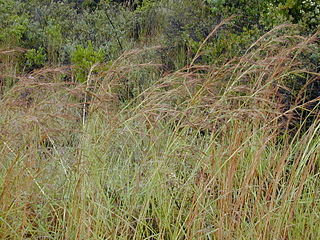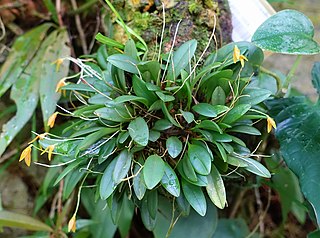
Magnolia is a large genus of about 210 to 340 flowering plant species in the subfamily Magnolioideae of the family Magnoliaceae. It is named after French botanist Pierre Magnol.

Lygodium is a genus of about 40 species of ferns, native to tropical regions across the world, with a few temperate species in eastern Asia and eastern North America. It is the sole genus in the family Lygodiaceae in the Pteridophyte Phylogeny Group classification of 2016. Alternatively, the genus may be placed as the only genus in the subfamily Lygodioideae of a more broadly defined family Schizaeaceae, the family placement used in Plants of the World Online as of November 2019.

The Gomphrenoideae are a subfamily of the Amaranthaceae.

Terminalia is a genus of large trees of the flowering plant family Combretaceae, comprising nearly 300 species distributed in tropical regions of the world. The genus name derives from the Latin word terminus, referring to the fact that the leaves appear at the very tips of the shoots.

Prosopis juliflora is a shrub or small tree in the family Fabaceae, a kind of mesquite. It is native to Mexico, South America and the Caribbean. It has become established as an invasive weed in Africa, Asia, Australia and elsewhere. It is a contributing factor to continuing transmission of malaria, especially during dry periods when sugar sources from native plants are largely unavailable to mosquitoes.

Dodonaea is a genus of about 70 species of flowering plants, often known as hop-bushes, in the soapberry family, Sapindaceae. It has a cosmopolitan distribution in tropical, subtropical and warm temperate regions of Africa, the Americas, southern Asia and Australasia. By far the highest species diversity is in Australia. The genus is named after Rembert Dodoens, traditionally known as 'Dodonaeus'.

Hemigraphis is a genus of plants in the family Acanthaceae, consisting of nearly 40 species native to tropical Asia. Hemigraphis is similar to plants the genus Strobilanthes, with some species now placed there. Its native range is Nansei-shoto and from Indo-China to New Guinea.

Woodwardia is a genus of ferns in the family Blechnaceae, in the suborder Aspleniineae of the order Polypodiales. Species are known as chain ferns. The genus is native to warm temperate and subtropical regions of the Northern Hemisphere. They are large ferns, with fronds growing to 50–300 cm long depending on the species. The fossil record of the genus extends to the Paleocene.
Lithophila radicata is a species of plant in the family Amaranthaceae. It is endemic to Ecuador.
Alternanthera subscaposa, synonym Lithophila subscaposa, is a species of plant in the family Amaranthaceae. It is endemic to the Galápagos Islands.

Picramnia, the bitterbushes, is a genus of plant considered to be in the family Picramniaceae, but sometimes placed in Simaroubaceae. The name is conserved against the genera Pseudo-brasiliumAdans., and TaririAubl., both which have been rejected.

Uvaria is a genus of flowering plants in the family Annonaceae. The generic name uvaria is derived from the Latin uva meaning grape, likely because the edible fruit of some species in the genus resemble grapes.

Hyparrhenia is a genus of grasses. Many species are known commonly as thatching grass.

Jurinea is a genus of plants in the sunflower family.
Elymandra is a genus of African and South American plants in the grass family. Most known species are native to Africa; one is found in Brazil.

Adiantum hispidulum, commonly known as rough maidenhair fern or five-fingered jack, is a small fern in the family Pteridaceae of widespread distribution. It is found in Africa, Australia, Polynesia, Malesia, New Zealand and other Pacific Islands. Its fronds rise in clumps from rhizomes among rocks or in the soil in sheltered areas.

Neoparrya lithophila, also known by the common names Bill's neoparrya and rock-loving aletes, is a species of flowering plant in the carrot family. It sometimes treated as the sole member of the monotypic genus Neoparrya, though other treatments place it in the genus Aletes.

Specklinia corniculata is a species of plant native to Belize, Colombia, Costa Rica, Cuba, French Guiana, Guatemala, Guyana, Haiti, Honduras, Nicaragua, Panama, Suriname, and Venezuela.
Cyperus confertus, also called the West Indian flatsedge is a species of sedge that is native to northern parts of South America.
Cyperus filiformis is a species of sedge that is native to northern parts of South America, southern parts of North America and parts of the Caribbean.














